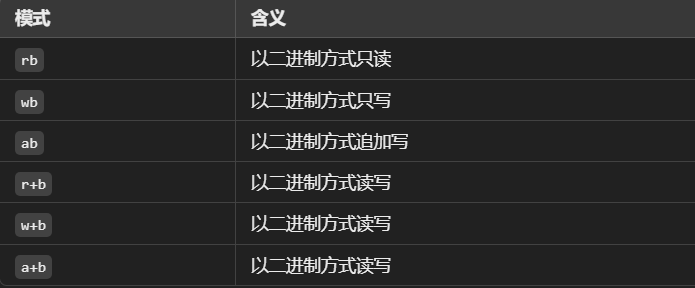打开文件
1
| FILE *freopen(const char *pathname, const char *mode, FILE *stream);
|
pathname:可以填写相对路径或绝对路径
stream:文件流
mode:模式(重点)
| mode |
含义 |
文件不存在 |
文件存在 |
| r |
只读 |
防护NULL(错误) |
从文件头开始读取 |
| w |
清空写入 |
创建新文件 |
清空文件内容,从头开始写入 |
| a |
追加写入 |
创建新文件 |
在文件末尾追加内容 |
| r+ |
读写 |
防护NULL(错误) |
从文件头开始读写 |
| w+ |
读写清空 |
创建新文件 |
清空文件内容,从头开始读写 |
| a+ |
读写追加 |
创建新文件 |
在文件末尾追加内容,但允许读写 |
上面是以文本形式进行操作,如果你想以二进制形式操作文件,只需要在 mode 后面添加 b 即可。

关闭文件
1
| int fclose(FILE *stream);
|
文件流不再需要使用,记得用 fclose 关闭。
读写文件
文本
(一)读写单个字符
1
2
3
| int fgetc(FILE *stream);
int fputc(int c, FILE *stream);
|
示例程序:
1
2
3
4
5
6
7
8
9
10
11
12
13
14
15
16
17
18
19
20
21
22
23
24
25
26
27
28
29
30
| void readFile(const char* path) {
FILE* src = fopen(path, "r");
if (!src) {
fprintf(stderr, "src fopen failed!!!");
exit(-1);
}
FILE* dst = fopen("b.txt", "w");
if (!dst) {
fprintf(stderr, "dst fopen failed!!!");
exit(-1);
}
char c;
while ((c = fgetc(src)) != EOF)
{
if ((c >= 'a' && c <= 'm') || (c >= 'A' && c <= 'M')) {
fputc(c + 13, dst);
}
else if ((c >= 'n' && c <= 'z') || (c >= 'N' && c <= 'Z')) {
fputc(c - 13, dst);
}
else {
fputc(c, dst);
}
}
fclose(src);
fclose(dst);
}
|
(二)读写一行
1
2
3
| char *fgets(char *s, int size, FILE *stream);
int fputs(const char *s, FILE *stream);
|
示例程序:
1
2
3
4
5
6
7
8
9
10
11
12
13
14
15
16
17
18
19
20
21
22
23
24
25
26
27
| #define MAX_LEN 128
void readFile(const char* path) {
FILE* src = fopen(path, "r");
if (!src) {
fprintf(stderr, "src fopen failed!!!");
exit(-1);
}
FILE* dst = fopen("b.txt", "w");
if (!dst) {
fprintf(stderr, "dst fopen failed!!!");
exit(-1);
}
char* line[MAX_LEN];
char* message[MAX_LEN];
int index = 1;
while ((fgets(line, MAX_LEN, src) != NULL))
{
sprintf(message, "%d. %s", index, line);
fputs(message, dst);
index++;
}
fclose(src);
fclose(dst);
}
|
(三)格式化地读写
1
2
3
| int fscanf(FILE *stream, const char *format, ...);
int fprintf(FILE *stream, const char *format, ...);
|
示例程序:
1
2
3
4
5
6
7
8
9
10
11
12
13
14
15
16
17
18
19
20
21
22
23
24
25
26
27
28
29
30
31
32
33
34
35
36
37
38
39
40
41
42
| #define MAX_LEN 128
#define NAME_LEN 20
typedef struct student
{
int id;
char name[NAME_LEN];
char sex;
int chinese;
int math;
int english;
} Student;
void readFile(const char* path) {
FILE* src = fopen(path, "r");
if (!src) {
fprintf(stderr, "src fopen failed!!!");
exit(-1);
}
FILE* dst = fopen("b.txt", "w");
if (!dst) {
fprintf(stderr, "dst fopen failed!!!");
exit(-1);
}
for (;;) {
Student s;
int n = fscanf(src, "%d%s %c%d%d%d", &s.id, s.name, &s.sex, &s.chinese, &s.math, &s.english);
if (n != 6) break;
s.chinese = s.chinese * 0.85;
s.math = s.math * 0.9;
s.english = s.english * 0.8;
fprintf(dst, "%d %s %c %d %d %d\n", s.id, s.name, s.sex, s.chinese, s.math, s.english);
}
fclose(src);
fclose(dst);
}
|
二进制
1
2
3
| size_t fread(void *ptr, size_t size, size_t nmemb, FILE *stream);
size_t fwrite(const void *ptr, size_t size, size_t nmemb,FILE *stream);
|
fread 的返回值是读取的大小,这个返回值将作为 fwrite size 参数。不然读取超出已读的长度会出现错误。
示例程序:
1
2
3
4
5
6
7
8
9
10
11
12
13
14
15
16
17
18
19
20
21
22
23
| #define MAX_LEN 128
void readFile(const char* path) {
FILE* src = fopen(path, "r");
if (!src) {
fprintf(stderr, "src fopen failed!!!");
exit(-1);
}
FILE* dst = fopen("b.txt", "w");
if (!dst) {
fprintf(stderr, "dst fopen failed!!!");
exit(-1);
}
char* data[MAX_LEN];
int n = 0;
while ((n = fread(data, 1, MAX_LEN, src)) > 0) {
fwrite(data, 1, n, dst);
}
fclose(src);
fclose(dst);
}
|
移动文件位置
1
2
3
4
5
| int fseek(FILE *stream, long offset, int whence);
long ftell(FILE *stream);
void rewind(FILE *stream);
|
其中 whence 参数有三个取值:
SEEK_SET: 文件开头,表示从文件的起始位置移动文件指针。
SEEK_CUR: 当前文件指针位置,表示从当前指针位置移动。
SEEK_END: 文件末尾,表示从文件末尾开始移动。
示例程序:
1
2
3
4
5
6
7
8
9
10
11
12
13
14
15
16
17
18
19
20
21
22
23
24
25
26
27
28
29
30
| char* readFile(const char* path) {
FILE* fp = fopen(path, "r");
if (!fp) {
exit(-1);
}
fseek(fp, 0, SEEK_END);
long int len = ftell(fp);
rewind(fp);
if (len == -1) {
exit(-1);
}
char* data = malloc(sizeof(char) * (len + 1));
if (!data) {
exit(-1);
}
size_t reNum = fread(data, 1, len, fp);
if (reNum != len) {
free(data);
fclose(fp);
exit(-1);
}
data[reNum] = '\0';
fclose(fp);
return data;
}
|
由于我们要把某个文件内容全部读取到数组中,但是我们又不知道要申请多大的空间,利用 刚刚介绍的方法就能轻松解决这个问题:
1
2
3
| fseek(fp, 0, SEEK_END);
long int len = ftell(fp);
rewind(fp);
|



